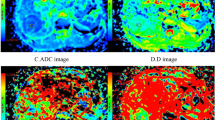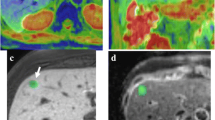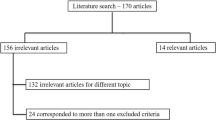Abstract
Purpose
To define correlations between the pathological grades of hepatocellular carcinomas (HCCs) and apparent diffusion coefficients (ADCs) derived using breath-holding diffusion-weighted imaging (BH-DWI).
Methods
We retrospectively evaluated 94 patients (105 lesions) with pathologically proved HCC who underwent hepatic DWI on a 3.0-T MR platform. HCCs were divided into five groups: well-differentiated (n = 10), well-to-moderately differentiated (n = 11), moderately differentiated (n = 51), moderately to poorly differentiated (n = 20), and poorly differentiated (n = 13) groups. The ADCs of carcinomas across different histological grades were compared by one-way analysis of variance. Spearman’s rank correlation test was used to analyze correlations between the degree of histopathological differentiation and ADC. Results were corrected for multiple comparisons using the Bonferroni correction.
Results
The BH technique yielded ADC values that differed significantly by the extent of differentiation (F = 8.392, p < 0.001). A significant negative correlation was found between the extent of differentiation and ADCs (r = −0.462, p < 0.001). The mean ADC values of poorly differentiated HCCs were significantly lower than the well-, well-to-moderately, moderately, and moderately to poorly differentiated HCCs (p values were <0.001, <0.001, 0.003, and 0.031, respectively).
Conclusion
ADC values obtained with BH-DWI may be of importance to non-invasively predict HCC tumor differentiation, and the extent of histological HCC differentiation was inversely correlated with ADC values.



Similar content being viewed by others
References
El-Serag HB (2002) Hepatocellular carcinoma: an epidemiologic view. J Clin Gastroenterol 35(5 Suppl 2):S72–S78
Thandassery RB, Goenka U, Goenka MK (2014) Role of local ablative therapy for hepatocellular carcinoma. J Clin Exp Hepatol 4(Suppl 3):S104–S111. doi:10.1016/j.jceh.2014.03.046
Arora A, Kumar A (2014) Treatment response evaluation and follow-up in hepatocellular carcinoma. J Clin Exp Hepatol 4(Suppl 3):S126–S129. doi:10.1016/j.jceh.2014.05.005
Ramesh H (2014) Resection for hepatocellular carcinoma. J Clin Exp Hepatol 4(Suppl 3):S90–S96. doi:10.1016/j.jceh.2014.07.002
Verslype C, Rosmorduc O, Rougier P, Group EGW (2012) Hepatocellular carcinoma: ESMO-ESDO Clinical Practice Guidelines for diagnosis, treatment and follow-up. Ann Oncol 23(Suppl 7):vii41–vii48. doi:10.1093/annonc/mds225
Kim SH, Lee WJ, Lim HK, Park CK (2009) SPIO-enhanced MRI findings of well-differentiated hepatocellular carcinomas: correlation with MDCT findings. Korean J Radiol 10(2):112–120. doi:10.3348/kjr.2009.10.2.112
Perez-Saborido B, de los Galanes SJ, Meneu-Diaz JC, et al. (2007) Tumor recurrence after liver transplantation for hepatocellular carcinoma: recurrence pathway and prognostic factors. Transplant Proc 39(7):2304–2307. doi:10.1016/j.transproceed.2007.06.059
Jonas S, Bechstein WO, Steinmuller T, et al. (2001) Vascular invasion and histopathologic grading determine outcome after liver transplantation for hepatocellular carcinoma in cirrhosis. Hepatology 33(5):1080–1086. doi:10.1053/jhep.2001.23561
Okusaka T, Okada S, Ueno H, et al. (2002) Satellite lesions in patients with small hepatocellular carcinoma with reference to clinicopathologic features. Cancer 95(9):1931–1937. doi:10.1002/cncr.10892
Zhou L, Rui JA, Wang SB, Chen SG, Qu Q (2015) Clinicopathological predictors of poor survival and recurrence after curative resection in hepatocellular carcinoma without portal vein tumor thrombosis. Pathol Oncol Res 21(1):131–138. doi:10.1007/s12253-014-9798-2
Cillo U, Vitale A, Bassanello M, et al. (2004) Liver transplantation for the treatment of moderately or well-differentiated hepatocellular carcinoma. Ann Surg 239(2):150–159. doi:10.1097/01.sla.0000109146.72827.76
Suh KS, Cho EH, Lee HW, et al. (2007) Liver transplantation for hepatocellular carcinoma in patients who do not meet the Milan criteria. Dig Dis 25(4):329–333. doi:10.1159/000106913
Nasu K, Kuroki Y, Tsukamoto T, et al. (2009) Diffusion-weighted imaging of surgically resected hepatocellular carcinoma: imaging characteristics and relationship among signal intensity, apparent diffusion coefficient, and histopathologic grade. AJR Am J Roentgenol 193(2):438–444. doi:10.2214/AJR.08.1424
An C, Park MS, Jeon HM, et al. (2012) Prediction of the histopathological grade of hepatocellular carcinoma using qualitative diffusion-weighted, dynamic, and hepatobiliary phase MRI. Eur Radiol 22(8):1701–1708. doi:10.1007/s00330-012-2421-6
Jin WC, Jeong ML, Soo JK, et al. (2013) Hepatocellular carcinoma: imaging patterns on gadoxetic acid–enhanced MR images and their value as an imaging biomarker. Radiology 267(3):776–786
Kogita S, Imai Y, Okada M, et al. (2010) Gd-EOB-DTPA-enhanced magnetic resonance images of hepatocellular carcinoma: correlation with histological grading and portal blood flow. Eur Radiol 20(10):2405–2413. doi:10.1007/s00330-010-1812-9
Choi JY, Kim MJ, Park YN, et al. (2011) Gadoxetate disodium-enhanced hepatobiliary phase MRI of hepatocellular carcinoma: correlation with histological characteristics. AJR Am J Roentgenol 197(2):399–405. doi:10.2214/AJR.10.5439
Chen J, Wu M, Liu R, et al. (2015) Preoperative evaluation of the histological grade of hepatocellular carcinoma with diffusion-weighted imaging: a meta-analysis. PLoS ONE 10(2):e0117661. doi:10.1371/journal.pone.0117661
Chang WC, Chen RC, Chou CT, et al. (2014) Histological grade of hepatocellular carcinoma correlates with arterial enhancement on gadoxetic acid-enhanced and diffusion-weighted MR images. Abdom Imaging 39(6):1202–1212. doi:10.1007/s00261-014-0168-z
Nakanishi M, Chuma M, Hige S, et al. (2012) Relationship between diffusion-weighted magnetic resonance imaging and histological tumor grading of hepatocellular carcinoma. Ann Surg Oncol 19(4):1302–1309. doi:10.1245/s10434-011-2066-8
Saito K, Moriyasu F, Sugimoto K, et al. (2012) Histological grade of differentiation of hepatocellular carcinoma: comparison of the efficacy of diffusion-weighted MRI with T2-weighted imaging and angiography-assisted CT. J Med Imaging Radiat Oncol 56(3):261–269. doi:10.1111/j.1754-9485.2012.02374.x
Chen X, Qin L, Pan D, et al. (2014) Liver diffusion-weighted MR imaging: reproducibility comparison of ADC measurements obtained with multiple breath-hold, free-breathing, respiratory-triggered, and navigator-triggered techniques. Radiology 271(1):113–125
Nishie A, Tajima T, Asayama Y, et al. (2011) Diagnostic performance of apparent diffusion coefficient for predicting histological grade of hepatocellular carcinoma. Eur J Radiol 80(2):e29–e33. doi:10.1016/j.ejrad.2010.06.019
Le Moigne F, Boussel L, Haquin A, et al. (2014) Grading of small hepatocellular carcinomas (≤ 2 cm): correlation between histology, T2 and diffusion-weighted imaging. Br J Radiol 87(1041):20130763. doi:10.1259/bjr.20130763
Taouli B, Sandberg A, Stemmer A, et al. (2009) Diffusion-weighted imaging of the liver: comparison of navigator triggered and breathhold acquisitions. J Magn Reson Imaging 30(3):561–568. doi:10.1002/jmri.21876
Kwee TC, Takahara T, Koh DM, Nievelstein RA, Luijten PR (2008) Comparison and reproducibility of ADC measurements in breathhold, respiratory triggered, and free-breathing diffusion-weighted MR imaging of the liver. J Magn Reson Imaging 28(5):1141–1148. doi:10.1002/jmri.21569
Kele PG (2010) Diffusion weighted imaging in the liver. World J Gastroenterol 16(13):1567. doi:10.3748/wjg.v16.i13.1567
Muhi A, Ichikawa T, Motosugi U, et al. (2009) High-b-value diffusion-weighted MR imaging of hepatocellular lesions: estimation of grade of malignancy of hepatocellular carcinoma. J Magn Reson Imaging 30(5):1005–1011. doi:10.1002/jmri.21931
Gourtsoyianni S, Papanikolaou N, Yarmenitis S, et al. (2008) Respiratory gated diffusion-weighted imaging of the liver: value of apparent diffusion coefficient measurements in the differentiation between most commonly encountered benign and malignant focal liver lesions. Eur Radiol 18(3):486–492. doi:10.1007/s00330-007-0798-4
Choi JS, Kim MJ, Chung YE, et al. (2013) Comparison of breathhold, navigator-triggered, and free-breathing diffusion-weighted MRI for focal hepatic lesions. J Magn Reson Imaging 38(1):109–118. doi:10.1002/jmri.23949
Watanabe H, Kanematsu M, Goshima S, et al. (2014) Characterizing focal hepatic lesions by free-breathing intravoxel incoherent motion MRI at 3.0 T. Acta Radiol 55(10):1166–1173. doi:10.1177/0284185113514966
Funding
This study was supported by the Capital Health Research and Development Special Fund (No. SF 2011-5001-05) of China. The funder played no role in the study design, data collection or analysis, decision to publish, or preparation of the manuscript.
Author information
Authors and Affiliations
Corresponding author
Ethics declarations
Conflict of interest
The authors report no conflicts of interest.
Ethical approval
All procedures performed in studies involving human participants were in accordance with the ethical standards of our hospital and with the 1964 Helsinki declaration and its later amendments or comparable ethical standards.
Rights and permissions
About this article
Cite this article
Tang, Y., Wang, H., Ma, L. et al. Diffusion-weighted imaging of hepatocellular carcinomas: a retrospective analysis of correlation between apparent diffusion coefficients and histological grade. Abdom Radiol 41, 1539–1545 (2016). https://doi.org/10.1007/s00261-016-0715-x
Published:
Issue Date:
DOI: https://doi.org/10.1007/s00261-016-0715-x




